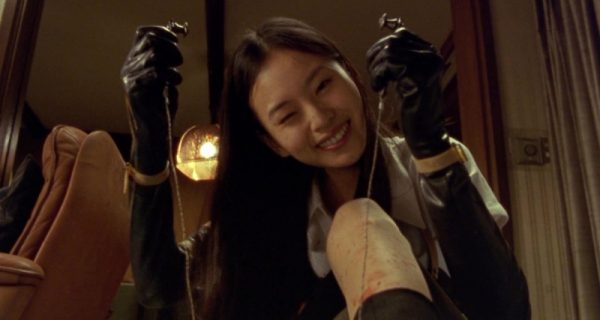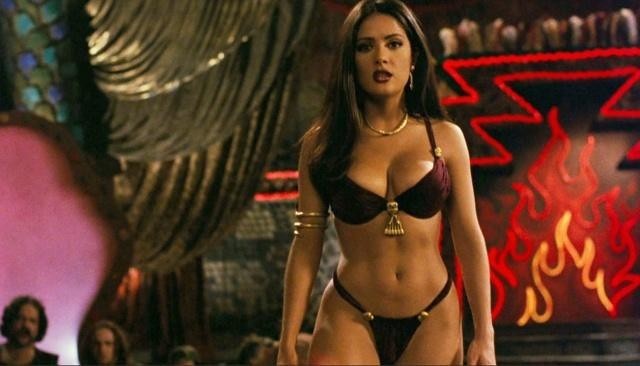EJ Moreno on Takashi Miike and his influence on horror…
If you’re reading this now, you probably were the type of person who used to hunt for “the most disturbing movies of all time” lists. We’ve all been there, and it carried us all through a wild era. The need for shock films hit an all-time high in the 00s with the rise of American torture porn and New French Extremity films.
But one country, particularly one filmmaker, fed us well during this era. Today, we’ll look at Takashi Miike, the prolific Japanese director. And when I say prolific, I’m not kidding, as the filmmaker currently sits with over 110 directing credits on IMDB.
Miike has directed many projects, including television and film while exploring every genre. For this piece, we are focusing on Miike’s work in the formative shock horror period. Between 1999 and 2010, the filmmaker found a niche with some of the most bizarre and challenging genre entries. Each turning point during this decade had a signature Miike horror experience, and it’s safe to say that gore and horror were forever changed.
There’s no discrediting Takashi Miike’s work in the 1990s; it felt like Miike and Lars Von Trier spent the decade preparing to become the new millennium’s wildest filmmaker. But in 1999, it was clear that Miike was ready to be looked at as the guy.
Audition is easily one of Miike’s most famous films; if you remember Bravo’s The 100 Scariest Movie Moments, this one is for you. With this 1999 entry, he quickly shifted the genre with his brilliant script and signature shock moments. It’s a highly well-crafted nightmare, smartly twisting everything you’d expect on its head. And the craziest part? It almost feels effortless in its insanity, like you can see that everything Miike made before prepared him to tackle horror in this way.
Lead actor Ryo Ishibashi recalls Miike feeling at home when filming the signature finale; Ishibashi said at the time that Miike was “having so much fun with that scene.” Seeing a filmmaker find a way into a genre and feel at ease was refreshing. While Miike had bent genre conventions before, this is the first horror entry after years of yakuza films and manga adaptations.
Speaking of yakuza works from Miike, Dead or Alive is a seminal entry into the genre with the filmmaker’s ultra-violence sprinkled throughout. It was wildly refreshing and helped usher in Miike’s new era with heavy inspirations from his past work. Though, he’d perfect the mix of brutality and the yakuza world with his 2001 entry Ichi The Killer.

For many, Ichi The Killer is Miike’s masterpiece. It combines many of his sensibilities, including a perverse tone with insane gore. But there’s also something genuinely comic book about the whole thing.
That style is something we’d see emulated so often. If everyone tried to copy the gore we saw in Audition, you could see Miike’s Ichi The Killer all over every other 2000s movie. While they never tried to hit the gore or sexuality of Ichi, the actual aesthetic of his work felt homaged by some of the most prominent filmmakers.
The hyper-insane editing became the thing to do in the 00s soon after this film; think about 2004’s Saw and how they’d piece together some of its biggest traps. And you can’t deny the face of the film, Kakihara, became a massive inspiration for Christopher Nolan and Heath Ledger for the Joker.
Now that Miike was starting to become part of horror pop culture, he pushed back at his place with one of his most shocking works. The same year as Ichi The Killer, Miike dropped Visitor Q, one of his most challenging and downright offensive works. When everyone wanted to make the next Takashi Miike project, he created something no one would ever attempt, allowing the highly sexual and wildly strange Visitor Q to stand out. No one could replicate that type of madness.
The next few years marked another turning point, and the filmmaker was seemingly at a crossroads in the industry. His next few moves could turn him into the next John Waters or David Lynch. Would he become a weird cult filmmaker, or could he become something more mainstream after years of shock? In his mid-00s era, all he did was continue the path to becoming the premiere Japanese auteur.

A return to horror would be in his future, but Miike decided to continue to bend genres like never before. In 2004, the filmmaker dropped Gozu, one of the most bizarre films ever. We could spend 8 hours together, and it would still be impossible to explain. This is where the path to the next David Lynch came into form, with the shock and confusion delighting the director but stumping audiences.
In an interview for the DVD, Miike said the film was “very unusual, even for a Japanese film.” This feels like an understatement, but we have to admire the self-awareness. He understood his position and the work he was creating, almost like he accepted his fate as the mystical and strange filmmaker casting a spell over us all.
His influence was over the mid-oos, even finding time to cameo in 2005’s Hostel from fellow horror icon Eli Roth. His character warns the lead in the film to “be careful…you could spend all your money in there,” which was his warning to us shock art and gore hounds. We should turn away now or be forever in the genre’s clutches.
From here, Miike would direct One Missed Call, which seemed less shocking than his previous works but proved to be just as influential. Even without all the shock and gore, no one could replicate what he was doing, as the American remake of One Missed Call is often considered one of the worst horror films ever.
Now that he had public admiration from American filmmakers and remakes of his work, Miike would venture to an American production, which would seal his fate in the mainstream forever.
In another key memory for 00s horror fans, Showtime’s Masters of Horror felt like the place to be. Some of the biggest names in the genre were brought together to showcase some of the best works in a short format. Of course, you’d expect Takashi Miike to get a call for this project, and he did.
Imprint was the film Miike presented as his work in Masters of Horror, and it was an insane film, as you’d expect – torture porn, gore, shocking moments – all steeped in social commentary about the Americans and Japanese. It’s a masterful film and deserved its showcase, but it was deemed too controversial for cable television. The episode was banned and regulated to the physical media release that would come later.
A few years back, Miike spoke about the backlash the film received. He recalls, “Everyone kept telling me that America’s a free country and that I could really do whatever I wanted. It’s cable TV, so don’t hold back and make it as scary as possible. So I did that, and then when I showed it to the producers in Japan, they were like, “I know we told you that you can do anything, but this is going too far. This is way too far.'”
We wouldn’t see Miike court American audiences ever again from this moment. It seemed like his time in the spotlight was done until American horror and action films caught up with the filmmaker, and he’d end the decade in the good graces of pop culture.

By the end of the 2000s and the start of the 2010s, mainstream cinema had changed, along with what horror fans were craving. Quentin Tarantino homaged splatter cinema with both Kill Bill Vol. 1 and Death Proof, and famous filmmakers like Martin Scorsese and Spike Lee turned to Asian films for remakes.
All that happened while endless remakes and mindless torture littered horror. We had seen prestige and shock mixed outside of the genre, so it was time for horror proper to do it. That’s where some of Miike’s most well-regarded come into play: 13 Assassins & Hara-Kiri.
Samurai cinema played a significant part in Takashi Miike’s cinematic upbringing. The filmmaking was done perfectly when he explored the genre. 13 Assassins saw Miike go full Akira Kurosawa but still kept his signature love of blood. It was gritty without trying too hard and impactful without relying too much on social commentary, all while being beautiful.
The film is one of Miike’s highest on Rotten Tomatoes, and the acclaim helped land the film ten nominations at the 34th Japan Academy Prize, for which it won four. 13 Assassins showed American audiences and horror fans that there was a place for Miike to exist in both prestige and cult status. He walked that world again with Hara-Kiri: Death of a Samurai.
Another period drama and remake, Miike held nothing back and delivered on the promised Hara-Kiri in the title. Much like his peer Tarantino, his work’s most brutal and horror-filled moment feels more digestible given the film’s more polished vibes. It doesn’t make it any less impactful or horrifying, but it’s a sneaky way of showing viewers extremity outside of something like Evil Dead or Tokyo Gore Police.
Hara-Kiri: Death of a Samurai is almost the gateway to the now-done-to-death “elevated horror” movement. The film also has the wild distinction of being the first 3D film to screen at the Cannes Film Festival – another example of Miike finding a way to add his signature WTF style to the mainstream film world.

No matter where Takashi Miike was in his career, it felt like horror was trying to catch up to him. Hell, most of your favorite directors tried to keep up with the insane work Miike was putting out during the millennium.
Looking at what horror has grown through in the last twenty years, it’s easy to point the figure at Miike and his amazingly impactful work. We saw shock cinema, gory movies, and prestige horror all from Miike before the mainstream parts of the genre even thought of going there.
It’s finally time Takashi Miike’s name is added to the legendary horror icon line-ups that often include Hitchcock, Carpenter, Raimi, and Cronenberg.
SEE ALSO: The Craziest Takashi Miike Movies
EJ Moreno


















